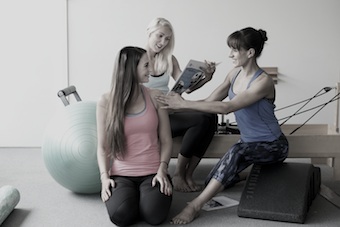Clinical Pilates for Physiotherapy students: What you need to know
Clinical Pilates for Physiotherapy students: What you need to know. by Rebecca Rose (BSc Hons, Equine Sports Massage Certificate, APPI Student Representative)
Clinical Pilates has a very personal meaning for me: it helped me to prepare for, and rehabilitate from spinal surgery. So, as both a client and a current Physio student, I can clearly see the benefits of Pilates. But many students are probably thinking: “I’m just a Physio student: why should I start to think about Pilates?” or even “what is Pilates?” Well, sit back, grab a cuppa tea (or a protein shake) and lets have a bit of a look at Clinical Pilates, and how you can become qualified to use it in clinical practice.
What is Pilates?
There are many variations on how Pilates is taught and practiced. But in its core (you’ll get the pun later) of all Pilates practice are a number of common components. Pilates focuses on the core stabilising muscles (get it now?), spinal alignment, posture, and breathing. It uses exercises (with or without the use of equipment) to improve physical strength, flexibility, posture, and self-awareness.
Where did Pilates start?
Back at the turn of the 21st century, a German man called Joseph Pilates developed the concept of Pilates (which he originally termed ‘Contrology’). Joseph suffered from multiple health conditions growing up (asthma, rickets, rheumatic fever), which led him to dedicate his life to building his own physical strength. He was influenced by body building, yoga, martial arts, gymnastics, and the movement of animals. Joseph actually led quite an interesting life; check out this YouTube animated video for more information about Joseph Pilates: https://www.youtube.com/watch?v=vWkxhtfw0A8
Why should I use Pilates with my clients?
There are a number of benefits a client can gain from Pilates, including improving their flexibility, balance, strength, and muscle tone. With a big focus on the core stabilising muscles, Pilates can assist clients who have chronic pain, such as low back pain.
Matwork vs. Equipment
Matwork Pilates is basically what it sounds like it is. Exercises are done on a gym mat, without the use of any equipment. Equipment Pilates utilised various forms of equipment, and is where you start to learn a whole new vocabulary of words. Soon you’ll be talking about reformers, magic rings, and cadilacs (of the non-automobile type) to your family while they stare blankly at your alien language. Equipment-based Pilates is mostly restricted to Physiotherapy clinics.
The underlying concepts of matwork and equipment Pilates are the same. Equipment Pilates can provide a greater variety of exercises and may be a bit more interesting for clients to pursue. However, the benefit of matwork Pilates is that you don’t need any fancy or expensive equipment, and clients can practice the exercises at home. Often a combination of both matwork and equipment Pilates is used with clients to give further variety both physically and mentally.
Where do I start?
Unite Health Management offers both matwork and equipment courses for Physiotherapists, and caters for final year Physio students wishing to start their Pilates training with the Matwork 1 course. It is recommended to start with the APPI Matwork Level 1 course, which introduces the APPI Pilates method. Following this, you can go on to complete the remainder matwork courses, equipment courses, or CPD courses. Check out the website for further information on the courses on offer: https://unitehealth.com.au/course-outlines/
If you plan on working in a clinic that has equipment available, it is suggested that you enrol in the full Matwork and Equipment certification series. For more information on Pilates training at Unite Health Management, check out this blog: https://unitehealth.com.au/pilates-training-where-do-i-start/
What am I qualified to do (practice with) with each course?
Once you have completed a course, you can immediately implement new skills into clinical practice (provided you are adequately covered by insurance and scope of practice, which you should be if you are practicing as a Physio). The Matwork 1 course enables you to deliver one to one programs, while Matwork 2 extends this scope to running group classes. If you would like to become certified or endorsed by the APPI, you will need to pass exams that follow completion of each of the Matwork and Equipment series.
Have I piqued your interest in Pilates? Where to now?
Hopefully this blog has given you a brief overview of where to start on your Pilates journey. My advice? There is nothing better than trying before you buy. Go take a Pilates class: see what it’s all about. Try matwork and try equipment Pilates with your Physio. This way you can see the benefits yourself and be able to relate to your clients more easily. And take advantage of the Unite Health Management APPI courses organised through your uni, along with any student discounts. This will give you another set of skills for your Physio toolbox and will no doubt give your CV an edge when you graduate.
Want more info on how to get your Pilates qualifications? Contact 03 9981 1860 or email info@unitehealth.com.au

